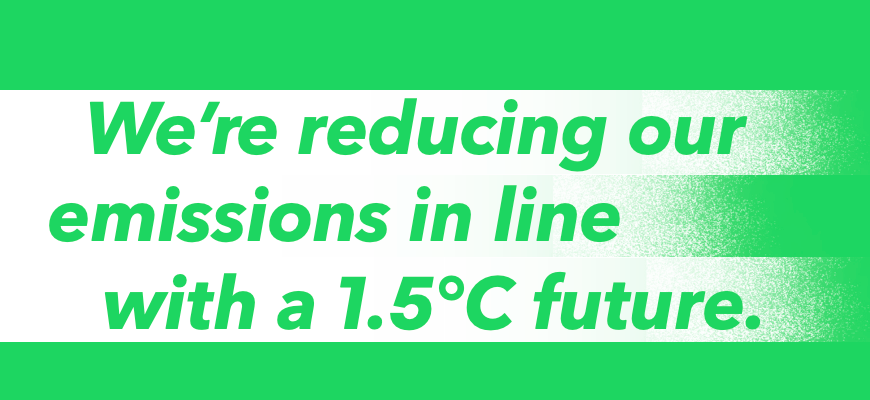Bloomberg Impact Report 2022: Reducing Our Emissions

Originally Published in Bloomberg's 2022 Impact Report
Bloomberg strives to decouple company growth from environmental impact while increasing the efficiency and resiliency of our operations. Our environmental performance targets are aligned with multinational efforts to limit the global temperature rise to 1.5°C above pre-industrial levels and avoid catastrophic climate change.
Carbon emissions reductions and targets.
We’re pursuing aggressive emissions reductions in line with best practices. Bloomberg is committed to reducing the company’s greenhouse gas (GHG) emissions in line with a 1.5°C future. Our near-term science-based targets aim for an 80 percent reduction in our absolute Scope 1 and 2 emissions and a 30 percent reduction in our absolute Scope 3 emissions by 2030 from a 2018 baseline. These targets have been validated by the Science-Based Targets initiative (SBTi), confirming that they are in line with the global emissions reductions necessary to limit the global temperature rise to 1.5°C.
Our targets build on previous commitments we’ve made, including our RE100 pledge to obtain 100 percent of our electricity from renewable sources by 2025. Achieving our RE100 objective will satisfy the 80 percent reductions in Scope 1 and 2 emissions we are pursuing.
In early 2023, SBTi also validated Bloomberg’s overall science-based net-zero target to reach net-zero greenhouse gas emissions across our value chain by 2040 from a 2018 base year, which includes long-term absolute emissions reduction targets of 90 percent across our global Scope 1, 2 and 3 emissions.
The road to net zero
We are committed to achieving our near-term and long-term science-based targets in accordance with a less-than 1.5°C future-warming scenario. We plan to achieve this through ongoing asset optimizations to reduce energy consumption and associated carbon emissions, continued investment in renewable energy projects and increased rigor in our procurement and travel activities.
Currently, Bloomberg is purchasing and retiring carbon credits from three climate change projects to offset our ongoing business travel emissions. Starting in 2025, we will expand this effort to cover all residual operational CO2 e emissions.
Once we meet our long-term science-based target reductions, these emissions offsetting efforts will result in Bloomberg receiving SBTi’s official net-zero designation.
Reducing our energy use is a top priority.
As a company with approximately 22,000 employees based in 166 locations globally, addressing our global energy consumption is critical to reducing our environmental impact. Bloomberg’s energy strategy is comprehensive, focusing on reducing absolute energy consumption, implementing energy efficiency projects at our facilities, occupying environmentally certified new facilities and investing in developing both on- and off-site renewable energy projects.
Bloomberg’s energy profile is dominated by electricity, comprising 90.2 percent of our total energy consumption. Fuel usage, cooling and hot water account for the remaining 9.8 percent of energy use. In 2022, we consumed 352,686 megawatt hours (MWh) of electricity across our global operations, an increase of 2.9 percent from 2021. Electricity consumption across our data centers rose by 5.6 percent as a result of increased capacity. Despite more employees and visitors using our buildings in 2022, electricity consumption at our offices fell by 1 percent, reflecting the effectiveness of ongoing optimizations.
Renewable energy
In 2022, we secured 192,533 MWh of renewable energy, an increase of 9.7 percent from 2021, from 10 on- and off-site solar and wind sites and a hydropower allocation from a local utility. Sourced renewable energy from these projects represents 54.6 percent of our global purchased electricity, up from 51.2 percent in 2021.
We began investigating renewable energy projects in 2008; our first project, a 1.8MW solar installation at our campus in Princeton, New Jersey, began providing us with energy in 2012. In 2021, we expanded our solar energy capacity in Princeton, developing an additional 2.55 MW solar project at our offices there. In March 2022, the project went live, with solar energy now providing 100 percent of the electricity needed for the two buildings on site.
Currently, our biggest challenge is procuring renewable energy outside the U.S. Countries have different markets, incentives and availability, and Bloomberg has lower energy needs in these locations. In these regions, efforts during 2022 were focused on securing Renewable Energy Guarantee of Origin (REGO) certificates and EU Guarantee of Origin (GO) certificates — certificates that guarantee that our suppliers obtain energy from renewable sources — bundled with our energy purchases. This approach helped us source an additional 46,782 MWh of renewable energy, equal to 13.3 percent of our global electricity consumption.

